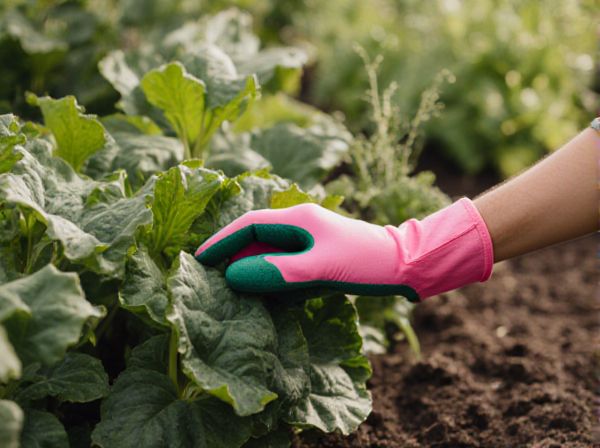
Cover Cropping vs Sheet Mulching Illustration
Cover cropping improves soil health by adding organic matter and preventing erosion, promoting nutrient cycling and moisture retention. Sheet mulching suppresses weeds and conserves soil moisture through layered organic materials, mimicking natural forest floor processes. Combining both methods can enhance soil fertility and weed control, creating a sustainable environment for healthy weed growth management.
Table of Comparison
| Aspect | Cover Cropping | Sheet Mulching |
|---|---|---|
| Weed Suppression | Effective through dense plant growth that outcompetes weeds. | Highly effective by blocking sunlight and physically preventing weed growth. |
| Soil Health | Improves fertility via nitrogen fixation and organic matter addition. | Enhances soil structure and moisture retention with layered organic material. |
| Labor Intensity | Requires planting and periodic management of cover crops. | Initial setup is labor-intensive; minimal maintenance afterward. |
| Cost | Moderate cost for seeds and planting. | Variable cost depending on mulch materials availability. |
| Environmental Impact | Supports biodiversity and reduces erosion. | Recycles organic waste and reduces chemical herbicide use. |
| Best Use | Large-scale or crop rotation systems needing soil improvement. | Small gardens or areas needing rapid weed control and soil building. |
Understanding Cover Cropping and Sheet Mulching
Cover cropping involves planting specific plants like clover or rye to naturally suppress weed growth by competing for nutrients and improving soil health. Sheet mulching uses layers of organic materials such as cardboard and compost to block sunlight, effectively preventing weed seeds from germinating. Both methods enhance soil fertility, moisture retention, and weed control, making them sustainable alternatives to chemical herbicides.
Benefits of Cover Cropping for Weed Control
Cover cropping effectively suppresses weeds by creating a dense canopy that blocks sunlight, reducing weed seed germination and growth. Leguminous cover crops improve soil fertility through nitrogen fixation, promoting vigorous crop growth that outcompetes weeds. Their root systems enhance soil structure and microbial activity, further inhibiting weed establishment and supporting sustainable weed management.
How Sheet Mulching Suppresses Weeds
Sheet mulching suppresses weeds by creating a thick, oxygen-limiting barrier that blocks sunlight and prevents weed seed germination. The layered combination of cardboard, organic matter, and mulch decomposes to improve soil health while physically inhibiting weed growth. This method reduces the need for herbicides by smothering existing weeds and minimizing new weed emergence in garden beds.
Best Plants for Effective Cover Cropping
Choosing effective cover crops like clover, ryegrass, and vetch enhances soil health by suppressing weeds through dense foliage and allelopathic properties. These plants improve nitrogen fixation and organic matter, creating a natural barrier against invasive weed species. Integrating cover cropping with sheet mulching can further reduce weed growth by combining living plant roots with layered mulch materials.
Materials Needed for Successful Sheet Mulching
Successful sheet mulching requires materials such as cardboard or newspaper to suppress weeds, organic mulch like straw or wood chips for moisture retention, and nitrogen-rich amendments including compost or manure to enhance soil fertility. Proper layering ensures weed smothering and soil improvement, promoting healthy plant growth. Utilizing these materials effectively creates a sustainable, low-maintenance weed control system.
Step-by-Step Guide to Implementing Cover Cropping
Implementing cover cropping involves selecting suitable cover crop species such as clover, rye, or vetch that suppress weed growth by shading and outcompeting unwanted plants. Begin by preparing the soil with light tilling or no-till methods to preserve soil structure, then evenly sow cover crop seeds before the off-season to establish strong coverage. Maintain the cover crop through regular monitoring, terminating it via mowing, rolling, or crimping before planting the main crop to ensure effective weed suppression and soil enrichment.
Sheet Mulching Techniques: Tips and Tricks
Sheet mulching techniques involve layering organic materials like cardboard, newspaper, and compost to suppress weed growth effectively by blocking sunlight and improving soil health. Applying mulch in thick, even layers and ensuring edges overlap prevents weed penetration and retains moisture, promoting robust plant growth. Incorporating diverse carbon-rich and nitrogen-rich materials balances decomposition, enhancing soil fertility while minimizing weed resurgence.
Comparing Costs: Cover Cropping vs Sheet Mulching
Cover cropping typically involves higher upfront costs for seed purchase and soil preparation but offers long-term benefits like improved soil fertility and reduced erosion, which can decrease future weed management expenses. Sheet mulching requires material costs for cardboard, mulch, and labor but provides immediate weed suppression and moisture retention, potentially lowering irrigation and herbicide needs. Evaluating the total investment against ecological impacts and crop yield improvements is crucial for determining the most cost-effective weed management strategy.
Environmental Impact of Each Method
Cover cropping enhances soil health by increasing organic matter, reducing erosion, and promoting biodiversity, which collectively suppress weed growth through natural competition. Sheet mulching minimizes weed emergence by creating a physical barrier that blocks sunlight while improving moisture retention and preventing soil degradation. Both methods reduce the need for chemical herbicides, but cover cropping offers greater long-term environmental benefits by fostering ecosystem resilience and nutrient cycling.
Choosing the Right Weed Management Strategy for Your Garden
Cover cropping enhances soil health and suppresses weeds by creating a dense plant barrier that outcompetes unwanted vegetation, making it ideal for long-term weed management. Sheet mulching, involving layers of organic materials like cardboard and compost, effectively smothers existing weeds and enriches soil fertility, providing immediate weed control benefits. Selecting the right strategy depends on garden goals, with cover cropping suited for sustainable soil improvement and sheet mulching preferred for quick weed suppression and soil conditioning.
Cover Cropping vs Sheet Mulching Infographic

 gardendif.com
gardendif.com